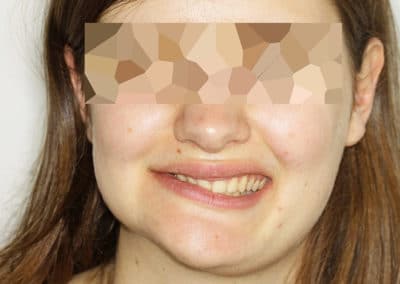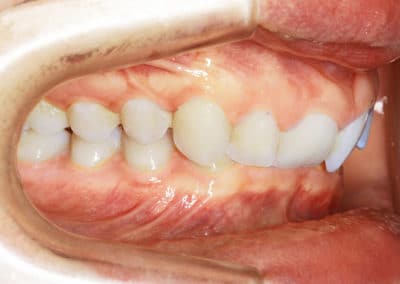Our smiles:
Orthognathic Surgery
A CASE OF A SURGICAL GAP
The duration of treatment was 26 months. Rigid wire restraints were placed superiorly and inferiorly from canine to canine on the lingual surfaces. Safety splints were also made.








A CASE OF MAXILLARY MIDLINE DEVIATION
The duration of treatment was 24 months. Rigid wire restraints were placed superiorly and inferiorly from canine to canine on the lingual surfaces. Safety splints were also made.








I HAVE A MANDIBULAR ASYMMETRY
At the end of the treatment, rigid restraining wires were placed on the lingual surfaces from canine to canine. Safety splints were also made.








I HAVE A STRONG ASYMMETRY
The clinical and radiological examination confirmed his reason for consultation and the treatment plan chosen was as follows: a mixed lingual treatment associated with mandibular advancement and maxillary expansion surgery. The patient was informed beforehand that in cases of mandibular asymmetry, there are two components: a basal component that can be corrected by a recentering surgery, and a component that concerns the bony contours that can only be corrected by a contouring surgery, which can only be done in a second step. We also told him that it was rare that contouring surgery still seemed necessary to the patient after basal surgery, because the improvement related to basal surgery is very significant. Also, you will notice on the end photos that a remnant of asymmetry remains. This is indeed the symmetry of the bone contours.
The duration of treatment was 24 months. Rigid wire restraints were placed superiorly and inferiorly from canine to canine on the lingual surfaces. Safety splints were also made.








MY UPPER TEETH ARE TOO FAR FORWARD AND MY JAW IS RECESSED (CLASS II, 1)
After 24 months of treatment, rigid wire restraints were placed superiorly and inferiorly from canine to canine on the lingual surfaces. Safety splints were also made.






I HAVE A GINGIVAL SMILE
The treatment chosen was therefore a mixed lingual treatment with maxillary impaction and mandibular recentering. Rigid wire restraints were placed superiorly and inferiorly from canine to canine on the lingual surfaces. Safety splints were also made.










I CAN’T BITE ON MY FRONT TEETH
The diagnosis revealed a 4-mm Class II occlusion, lack of overlap, narrowness of the upper jaw, and a hyperdivergent Class II skeletal pattern. The treatment plan chosen was non-surgical palatal expansion with external – but could have been internal – bands and counterclockwise mandibular advancement surgery, as well as advancement genioplasty during the same surgical time. The treatment lasted 26 months. Rigid wire restraints were placed superiorly and inferiorly from canine to canine on the lingual surfaces. Safety splints were also placed.










